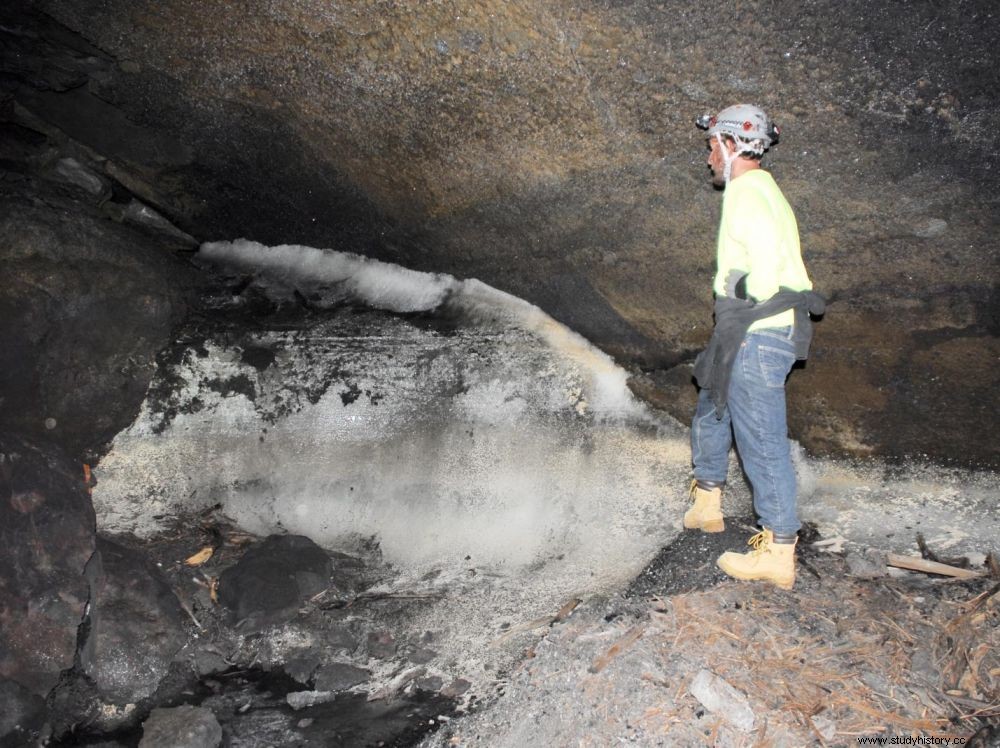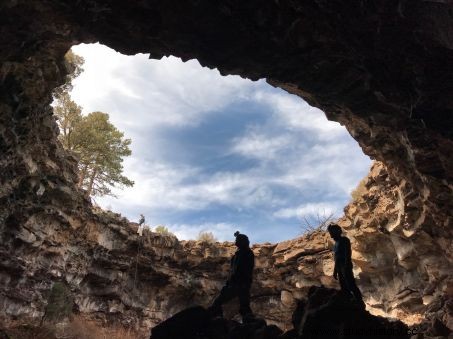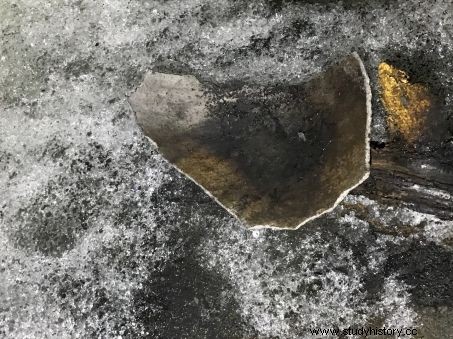While exploring a lava tube in New Mexico, geoscientists discovered that around 1,500 years ago, the ancestral Pueblos had managed to survive the drought by sinking deep into these tunnels. They harvested ancient ice there and turned it into drinking water.

Here, part of the ice exploited by the ancestral Pueblos in which the researchers found coal, a sign of human exploitation.
To the west of the current state of New Mexico in the United States lies volcanic, arid, rugged land. The Spanish explorers nicknamed them "El Malpais", or "cursed lands". Sometimes crushed by scorching temperatures, sometimes covered with snow in winter, they are not conducive to the establishment of human communities. However, complex Indian societies populated this inhospitable landscape more than 10,000 years ago, competing in ingenuity for their survival, especially from an architectural point of view (the various Pueblo tribes are known for their dwellings piled up in wood caulked with cob ).
This time, an international team of geoscientists, led by the University of South Florida (USF), discovered how the Pueblo Indian people managed to survive during periods of intense drought by going very deep into lava tunnels. , or lava tubes . His study is published Wednesday, November 18, 2020 in Scientific Reports .
Water at all costs
By exploring an ice-filled lava tube within El Malpais National Monument, a protected site, the team of Professor Bogdan Onac, from the Department of Geosciences at USF, was able to determine that the Ancestral Pueblos (Ancestral Puebloans ) had traveled to the heart of this tunnel to exploit the ice preserved inside, between 150 and 900 AD at least. Once melted, this ice would have constituted for these Men an essential water resource to survive during at least five devastating drought episodes which left traces in this geological formation.

The team at the entrance to the lava tunnel nicknamed "Cave 29". Credits:University of South Florida
To the west of the current state of New Mexico in the United States lies volcanic, arid, rugged land. The Spanish explorers nicknamed them "El Malpais", or "cursed lands". Sometimes crushed by scorching temperatures, sometimes covered with snow in winter, they are not conducive to the establishment of human communities. However, complex Indian societies populated this inhospitable landscape more than 10,000 years ago, competing in ingenuity for their survival, especially from an architectural point of view (the various Pueblo tribes are known for their dwellings piled up in wood caulked with cob ).
This time, an international team of geologists, archaeologists and paleoclimatologists, led by the University of South Florida (USF), discovered how the Pueblo Indian peoples managed to survive during periods of intense drought by going very deep in lava tunnels, or lava tubes . His study is published Wednesday, November 18, 2020 in Scientific Reports .
Water at all costs
By exploring an ice-filled lava tube within El Malpais National Monument, a protected site, the team of Professor Bogdan Onac, from the Department of Geosciences at USF, was able to determine that the Ancestral Pueblos (Ancestral Puebloans ) had traveled to the heart of this tunnel to exploit the ice preserved inside, between 150 and 900 AD at least. Once melted, this ice would have constituted for these Men an essential water resource to survive during at least five devastating drought episodes which left traces in this geological formation.

The team at the entrance to the lava tunnel nicknamed "Cave 29". Credits:University of South Florida
Exploration work has focused on a single lava tube, approximately 14 meters deep and probed 171 meters in length, located in the middle of a nearly 65 kilometer strip of ancient flows. True natural traps, many of these tunnels contain large deposits of ice, which were intended to be much larger in area nearly two millennia ago. Today, unfortunately, climate change has made them very fragile vestiges, reduced from year to year to a trickle.
Surviving a cruel climate
Researchers have identified charred material in the cave, indicating that the ancestral Pueblos lit small fires to melt the ice and collect it as drinking water, possibly for religious rituals. It was deposits of coal and ash, as well as a shard of pottery, that aroused the curiosity of scientists who initially came to the site to take an ice core for paleoclimate research. "I have entered many lava tubes, but this one was special due to the amount of charcoal on the floor in the deepest part of the cave" , said Bogdan Onac. "I thought that was interesting, but it wasn't until we found charcoal and soot in the ice core that the idea of linking the use of ice to a resource of water came to mind."

A shard of pottery found among the ashes. Credits:University of South Florida
It is therefore with an unexpected confirmation that the scientists came out of this exploration mission:the ancestral pueblo populations were indeed engaged in collecting water in the lava tubes, as assumed until now by archaeologists to whom material evidence was still missing. Researchers believe that in years when temperatures were more temperate, seasonal ice melt near cave entrances left shallow pools of water accessible to Ancestral Pueblos. But when the ice was absent during warmer, drier periods, the tribes were forced into the bowels of the earth.
